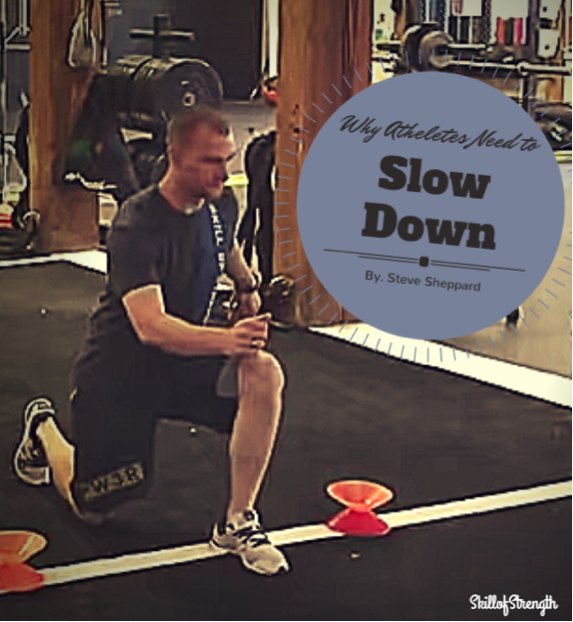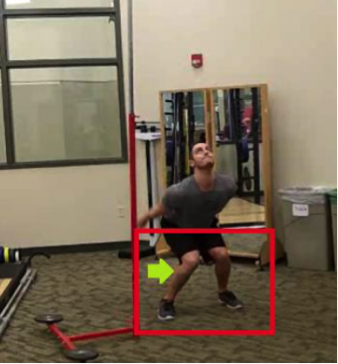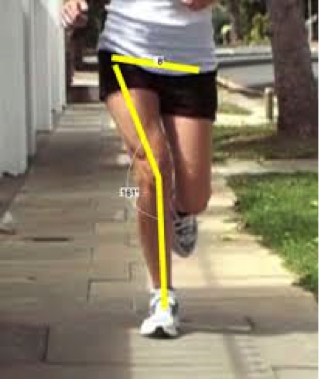
Bigger, faster, stronger… the goals of almost every competitive athlete. Although I don’t see the “MOBILE, EFFICIENT, CONDITIONED” t-shirts selling too well I’d argue that most athletes should be spending more time learning how to slow down!
What do I mean by slow down?
Athletes spend a whole lot of time trying to develop their speed and explosiveness. They place a huge emphasis on getting very good at accelerating. However, it’s also extremely important to learn how to slow down, or decelerate.
When an athlete changes direction he/she will accelerate in one direction, decelerate, re-route, and re-accelerate in another direction. It might be helpful to think about deceleration as the ability to control force throughout your body when jumping, landing, running, etc.
Why is deceleration important?
Learning how to properly decelerate will actually make you more efficient when changing direction. So, yes, I’m saying that you should learn how to slow down in order to become faster!
When you learn to decelerate properly, you will be able to keep your joint angles in a more optimal position for re-acceleration. If you are bad at slowing down, you’ll probably be in a poor biomechanical position when you need to speed back up again. If you don’t know how to absorb the impact on your joints during things like sprinting, there is a very good chance you will get injured. So, yup, you should also learn how to slow down in order to help prevent injuries!
You want to avoid what’s called a valgus knee when landing and running. If you watch any high school athletic event, you can be sure the athletic trainer is nervously staring at a bunch of knees caving in all over the place. So, give your joints a break, and prevent your athletic trainer (and your strength coach!) from having a panic attack by learning the following:
When jumping and landing, you want to prevent your knees from caving towards one another. Instead, the hip, knee and ankle should all be in a line during jumping (acceleration) and landing (deceleration).
Unlike the image below…

Proper deceleration is important while running as well in order to keep your joints properly aligned. While landing on your lead leg, you need to properly decerlate, loading your ankle, knee and hip, and then re-accelerate off that leg into your next step. Like the jumping and landing mechanics, your hip, knee and ankle should all be aligned for proper force production and to prevent over stressing your tendons and ligaments.
Again, the image below will show poor joint positioning.

Teaching your Body to Decelerate
Here are some of our favorite deceleration drills that work great for the things we discussed above.
Basic Squat Jump w/ decel Landing
Box jump into a step off- into a vert jump
Jog into a split lunge
Vertical Jump
Your Takeaways
There’s too much hype placed on building an athlete’s speed and power, both of which are related to an athlete’s acceleration. There’s not enough emphasis on teaching athletes to decelerate properly.
Although I do believe that acceleration absolutely plays a huge role in sports performance, lets not forget that deceleration training also must be practiced. Deceleration drills may not be all that sexy, but keep in mind, if you’re spending a large portion of your training getting your body to jump higher, run faster, swing or kick harder, you also need to take the time to train your body to support all that awesomeness.
You cannot jump, run and swing without being able to land, absorb, and slow down…at least not without breaking yourself down for very long!
So keep yourself healthy this season and add some deceleration drills into your program!

Keep up the good work Mike. Slowing down isn’t the sexy stuff that everyone likes to talk about on social media, but it is the foundation that all of that strength and power stands on. Great stuff!
Very good article man!
Great post! I have recommend it recently in a Tony Gentilcore’s post.
Keep it up!